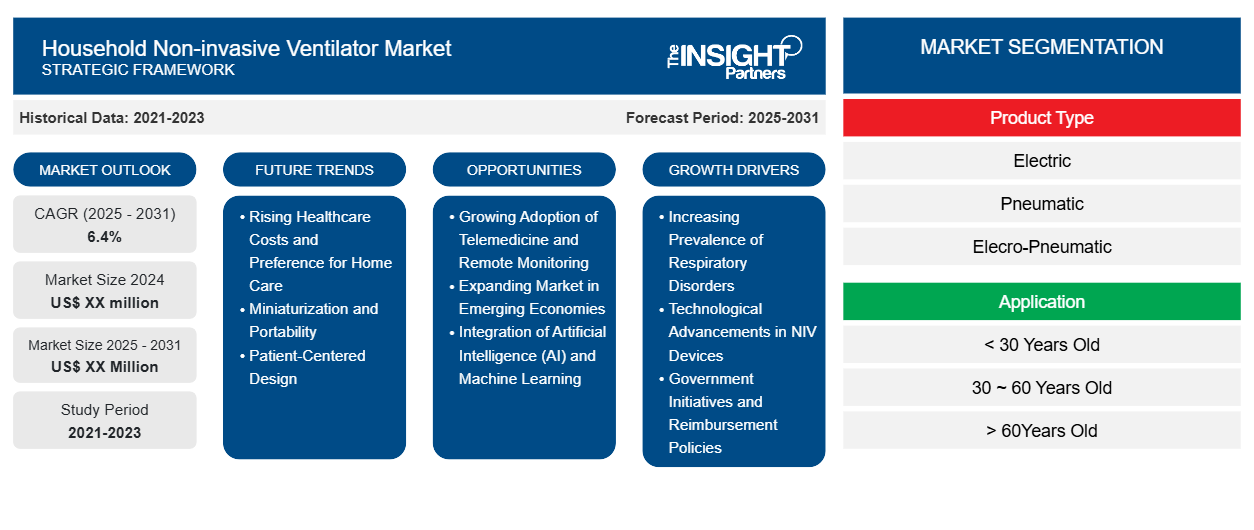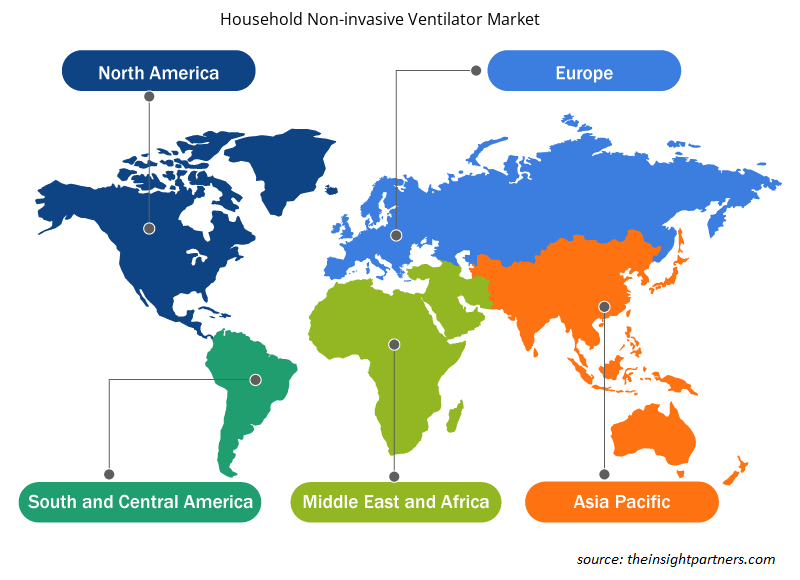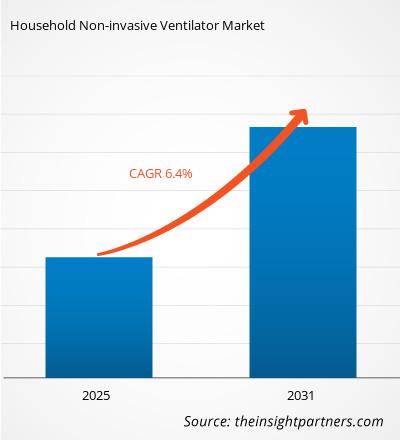家庭用非侵襲的人工呼吸器市場は、2025年から2031年にかけて6.4%のCAGRで成長し、市場規模は2024年のXX百万米ドルから2031年にはXX百万米ドルに拡大すると予想されています。
レポートは、製品タイプ(電動、空気圧、電空圧)別にセグメント化されています。レポートではさらに、アプリケーション(30歳未満、30〜60歳、60歳以上)に基づいた分析を提示しています。グローバル分析は、地域レベルと主要国でさらに細分化されています。レポートでは、上記の分析とセグメントに対してUSDでの価値を提供しています。
報告書の目的
The Insight Partners による家庭用非侵襲性人工呼吸器市場のレポートは、現在の状況と将来の成長、主な推進要因、課題、機会を説明することを目的としています。これにより、次のようなさまざまなビジネス関係者に洞察が提供されます。
- テクノロジープロバイダー/メーカー: 進化する市場の動向を理解し、潜在的な成長機会を把握することで、情報に基づいた戦略的意思決定が可能になります。
- 投資家: 市場の成長率、市場の財務予測、バリュー チェーン全体に存在する機会に関する包括的な傾向分析を実施します。
- 規制機関: 市場の濫用を最小限に抑え、投資家の信用と信頼を維持し、市場の完全性と安定性を維持することを目的として、市場における政策と警察活動を規制します。
家庭用非侵襲性人工呼吸器市場のセグメンテーション
製品タイプ
- 電気
- 空気圧
- 電気空圧式
応用
- 30歳未満
- 30~60歳
- > 60歳
要件に合わせてレポートをカスタマイズする
このレポートの一部、国レベルの分析、Excelデータパックなど、あらゆるレポートを無料でカスタマイズできます。また、スタートアップや大学向けのお得なオファーや割引もご利用いただけます。
家庭用非侵襲性人工呼吸器市場:戦略的洞察

- このレポートの主要な市場動向を入手してください。この無料サンプルには、市場動向から見積もりや予測に至るまでのデータ分析が含まれます。
家庭用非侵襲性人工呼吸器市場の成長要因
- 呼吸器疾患の罹患率の増加: 人口の高齢化、環境の悪化、ライフスタイルの変化により、COPD、OSA、神経筋疾患などの呼吸器疾患の罹患率が増加しています。慢性患者の間で NIV デバイスの需要が高まっているのは、在宅環境での長期人工呼吸器サポートを必要とする患者を管理する必要性が高まっているためです。
- NIV デバイスの技術的進歩: 設計の進歩により、非侵襲性人工呼吸器は小型化、効率化、ユーザーフレンドリー化が進み、家庭環境での導入が広く可能になりました。移動性、携帯性、使いやすさ、静かな動作、快適性などの利点が向上し、NIV デバイスの魅力が高まっています。リモート モニタリング アプリによるモバイル接続により、患者の活性化と管理のしやすさがさらに高まり、NIV がより実用的なオプションになります。NIV Devices: Advances in design have made the non-invasive ventilators smaller, efficient, and user-friendly, thus allowing widespread adoption into the home setting. Improved advantages, such as mobility, portability, ease of use, quiet operation, and comfort increase attractiveness toward NIV devices. Mobile connectivity with apps on remote monitoring further heighten patient activation and ease of management whereby NIV becomes a more practical option.
- 政府の取り組みと償還政策: 一部の国では、NIV 機器を含む在宅ケア機器に対する補助金を支給しています。償還に関するその他の政策は多くの地域で改善されており、より多くの患者層が NIV を利用でき、より手頃な価格で利用できるようになっています。これらの政策は、医療サービス提供者と患者が在宅ベースの人工呼吸器ソリューションに移行することを奨励しています。
家庭用非侵襲性人工呼吸器市場の将来動向
- 医療費の高騰と在宅ケアの好まれ方: 特に発展途上国では、医療制度への負担が増大しているため、入院や入院治療のコストを削減するために在宅ケアへの圧力が高まっています。NIV デバイスは、長期の呼吸補助を必要としているが、病院ではなく在宅で病状を管理したい患者にとって経済的な選択肢となります。
- 小型化と携帯性: 小型化の傾向により、NIV デバイスは携帯しやすく目立たなくなるだけでなく、快適に使用できるようになりました。今日では、ほとんどの患者が、自宅で簡単に持ち運べる小型で軽量のデバイスを好む傾向が高まっています。ほとんどの患者は、長期使用に適した、より優れた、より邪魔にならない手段というこの新しい傾向に魅力を感じています。
- 患者中心設計: NIV デバイスを開発して、使用することで患者の生活がより楽になり、より快適になるようにすることが非常に重要です。マスクの設計、ノイズ低減技術、その他の人間工学的機能の改良により、ユーザーの全体的な体験が大幅に向上しています。企業は、患者の遵守率を高めるために、NIV デバイスをより使いやすく、習得しやすいものにすることに重点を置いています。
家庭用非侵襲性人工呼吸器の市場機会
- 遠隔医療とリモート モニタリングの採用拡大: このように、遠隔医療は、特に慢性疾患の医療管理の迅速な方法として登場しています。NIV デバイスのリモート モニタリング機能により、医療従事者は患者の呼吸状態をリアルタイムで監視できるため、病院に行かなくても、時間に合わせて治療を調整できます。これにより、メーカーは、医療システムへの負担を不必要に増やすことなく、患者の治療成果を向上させることができる、より統合されたソリューションを作成する道が開かれます。
- 新興経済国における市場の拡大: アジア太平洋、ラテンアメリカ、アフリカの一部などの新興市場では、医療制度の進歩により、低コストでありながら効率的な呼吸器ソリューションの需要が高まっています。慢性呼吸器疾患に対する認識の高まりと医療サービスへのアクセスの向上は、NIV メーカーにとって、これらの地域での地理的展開を拡大する大きなチャンスとなります。
- 人工知能 (AI) と機械学習の統合: AI と機械学習を NIV マシンに組み込むことは、刺激的な可能性を表しています。AI アルゴリズムは、人工呼吸器の設定を最適化し、症状の悪化を予測し、リアルタイム データに基づいてカスタマイズされた治療を提供できます。このイノベーションにより、治療の精度と効率が向上し、よりスマートで適応性の高い NIV システムの可能性が広がります。
家庭用非侵襲性人工呼吸器市場の地域別分析
予測期間を通じて家庭用非侵襲性人工呼吸器市場に影響を与える地域的な傾向と要因は、Insight Partners のアナリストによって徹底的に説明されています。このセクションでは、北米、ヨーロッパ、アジア太平洋、中東、アフリカ、南米、中米にわたる家庭用非侵襲性人工呼吸器市場のセグメントと地理についても説明します。

- 家庭用非侵襲性人工呼吸器市場の地域別データを入手
家庭用非侵襲性人工呼吸器市場レポートの範囲
| レポート属性 | 詳細 |
|---|---|
| 2024年の市場規模 | XX百万米ドル |
| 2031年までの市場規模 | XX百万米ドル |
| 世界のCAGR(2025年~2031年) | 6.4% |
| 履歴データ | 2021-2023 |
| 予測期間 | 2025-2031 |
| 対象セグメント | 製品タイプ別
|
| 対象地域と国 | 北米
|
| 市場リーダーと主要企業プロフィール |
|
家庭用非侵襲性人工呼吸器市場のプレーヤー密度:ビジネスダイナミクスへの影響を理解する
家庭用非侵襲性人工呼吸器市場は、消費者の嗜好の変化、技術の進歩、製品の利点に対する認識の高まりなどの要因により、エンドユーザーの需要が高まり、急速に成長しています。需要が高まるにつれて、企業は提供を拡大し、消費者のニーズを満たすために革新し、新たなトレンドを活用し、市場の成長をさらに促進しています。
市場プレーヤー密度とは、特定の市場または業界内で活動している企業または会社の分布を指します。これは、特定の市場スペースに、その規模または総市場価値と比較して、どれだけの競合相手 (市場プレーヤー) が存在するかを示します。
家庭用非侵襲的人工呼吸器市場で事業を展開している主要企業は次のとおりです。
- レスメド
- 帝人ファーマ
- デビルビスヘルスケア
- フィリップス
- ローウェンシュタインメディカル
免責事項:上記の企業は、特定の順序でランク付けされていません。

- 家庭用非侵襲性人工呼吸器市場のトップキープレーヤーの概要を入手
主なセールスポイント
- 包括的なカバレッジ: レポートでは、家庭用非侵襲的人工呼吸器市場の製品、サービス、タイプ、エンドユーザーの分析を包括的にカバーし、全体的な展望を提供します。
- 専門家による分析: レポートは、業界の専門家とアナリストの深い理解に基づいてまとめられています。
- 最新情報: このレポートは、最新の情報とデータの傾向を網羅しているため、ビジネスの関連性を保証します。
- カスタマイズ オプション: このレポートは、特定のクライアント要件に対応し、ビジネス戦略に適切に適合するようにカスタマイズできます。
したがって、家庭用非侵襲性人工呼吸器市場に関する調査レポートは、業界のシナリオと成長の見通しを解読し理解する道の先導役となる可能性があります。いくつかの正当な懸念があるかもしれませんが、このレポートの全体的な利点は欠点を上回る傾向があります。
- 過去2年間の分析、基準年、CAGRによる予測(7年間)
- PEST分析とSWOT分析
- 市場規模価値/数量 - 世界、地域、国
- 業界と競争環境
- Excel データセット
最新レポート
お客様の声
購入理由
- 情報に基づいた意思決定
- 市場動向の理解
- 競合分析
- 顧客インサイト
- 市場予測
- リスク軽減
- 戦略計画
- 投資の正当性
- 新興市場の特定
- マーケティング戦略の強化
- 業務効率の向上
- 規制動向への対応




















 無料サンプルを入手 - 家庭用非侵襲性人工呼吸器市場
無料サンプルを入手 - 家庭用非侵襲性人工呼吸器市場